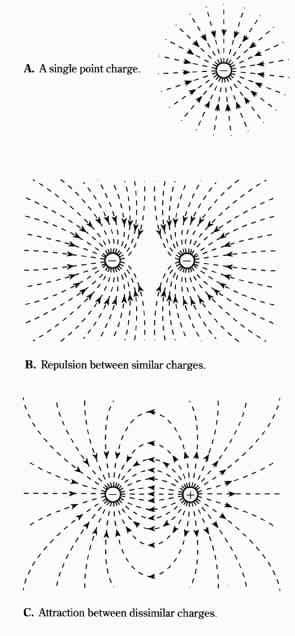AMAZON multi-meters discounts AMAZON oscilloscope discounts
.Pretend that our electrical technology exists and that you have a good grasp of it but that, somehow, electric motors have not yet been developed. Given the assignment to create such a device, how might you proceed? A reasonable way would probably be to investigate forces capable of acting on physical materials of some kind. Then, you would think of some way to produce torque, or a turning motion. This would be an encouraging step, but the torque would also have to be continuous, so that a constant rotation would ensue. However, the mere attainment of this objective might not result in a practical motor. For example, the well-known novelty item, the radiometer (FIG. 1), converts the energy of incident light photons to kinetic energy by the rotation of its windmill-like blades. But only a feeble torque is developed in such a device. It would be futile to provide the radiometer with a shaft so that work could be performed. Perhaps such an approach might be put aside reluctantly be cause certain instrumental applications could be visualized. But for use in the environment, this type of “motor action” does not appear promising.

FIG. 1 The radiometer. Light source
You might next consider electrostatic force. FIG. 2 displays the field pat terns of point charges. FIG. 3 shows an electrostatic voltmeter. Here, the attraction of unlike charges is evidenced as usable “motor action” in this device. To be sure, the rotation of the electrostatic voltmeter is not continuous, but perhaps this can be arranged. Of course, the torque developed by this meter movement is still woefully inadequate for the needs of industrial motive power. Maybe you would ponder whether an electrostatic motor could be devised to develop the turning power needed.

FIG. 2 The field pattern associated with electrostatic lines of force.
A. A single point charge.
B. Repulsion between similar charges.
C. Attraction between dissimilar charges.
Consider a current of one ampere. Such a current is readily produced by small batteries and is safely carried by ordinary 18-gauge hookup wire. Now, one ampere represents the flow past a point of approximately 3 x 10 electrostatic units of charge per second. Because the charge of the electron is 4.8 x 10_ electrostatic units, it follows that one ampere corresponds also to 6.25 x 10 electrons per second. This number of electrons is defined as the coulomb, so finally we say that one ampere of current flows in a circuit when the rate of charge is one coulomb per second. Apparently, the coulomb is not a wild concept described by fantastic numbers. In many ordinary electrical and electronic devices, you can expect to deal with currents ranging from several tenths to several tens of coulombs per second.
Using Coulomb’s law, it is easy to show that if two metallic spheres, one centimeter in diameter and separated by one meter, center to center, could somehow be oppositely charged with one coulomb of electricity, they would develop the fantastic attractive force of approximately one million tons. The conditional “somehow” is well used, for the potential difference developed by such an electrified system would be in the hundreds of teravolts. Long before such an astronomically high voltage could be brought into existence between the spheres, a cataclysmic lightning flash would have disintegrated the apparatus. If you scale down the charges and alter the geometrical configuration of the spheres, or plates, the best that can be accomplished falls miserably short of what is easily, compactly, and economically achieved when the basic motive force is derived from the interaction of magnetic fields. Fractional-horsepower motors using electrostatic forces have been experimented with, but they require many tens of thousands of volts, involve critical insulation techniques, and show little indication of practicality.

FIG. 3 The electrostatic voltmeter. Pivoted blade Fixed blades
Although the idea of electrostatic force as the torque-producing source for motors was dispensed, there are many who remain intrigued with the fantastically powerful force fields of electrons. Among these people, the feeling prevails that perhaps a radically different technique might yet be found to use this elemental force of nature to directly produce mechanical rotation at power levels suitable for industry.
A possible spur to the development of electrostatic motors is the great stride that has been made in the transmission of very high dc voltage. Also, there are whole new families of insulating materials that were nonexistent some years ago when interest declined in electrostatic motive power. Of considerable relevance, also, is the recently attained state of vacuum technology. The future might hold some interesting surprises for those who view electrostatic motive power as a dead issue.